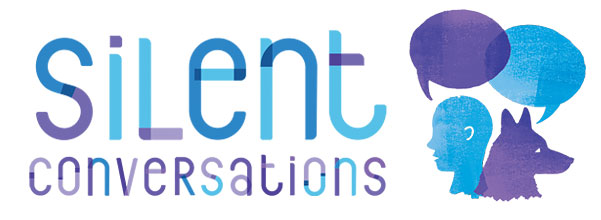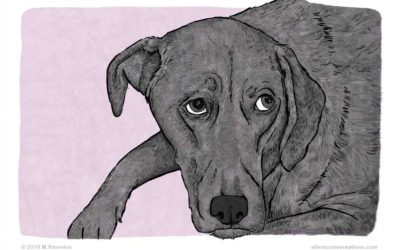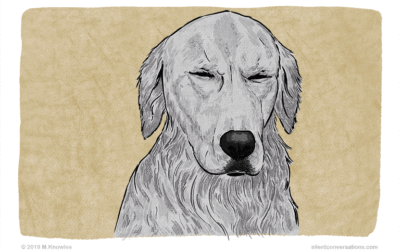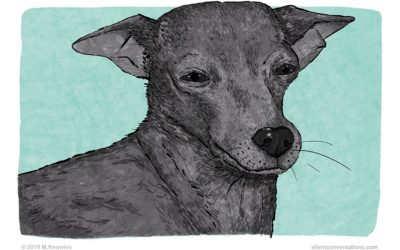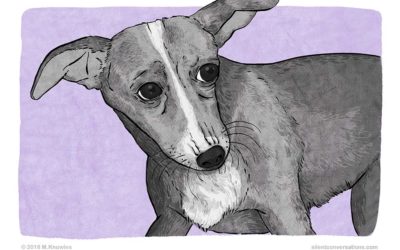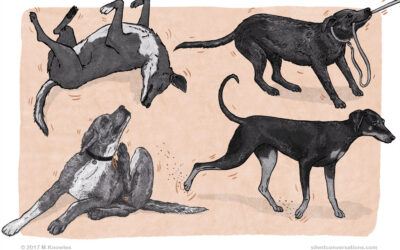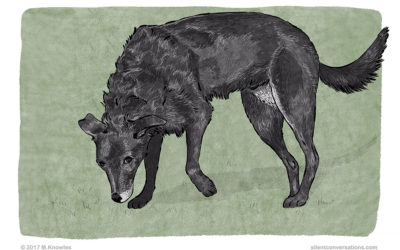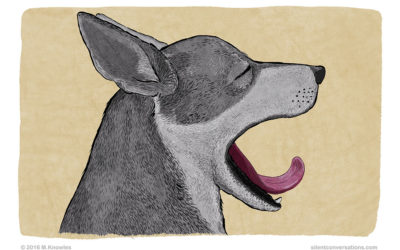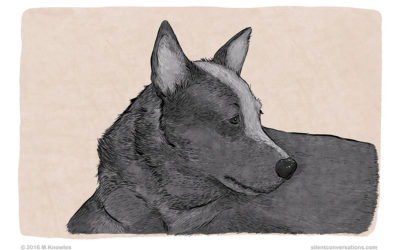
‘Raised Hackles’ or Piloerection – Dog Body Language
When a dog’s hair bristles up or stands on end over the spine region of the back, this is known as ‘raised hackles’ or technically defined as piloerection. The pattern area in which the hair raises can vary and display differently in each individual dog; the...
Scratching – Dog Body Language
When a dog scratches his shoulder or neck with his hind leg, this could be due to his having an itch, perhaps caused by skin irritation or allergies. However, it is important to pay attention to how often and in what context the scratching occurs. If it is due to a skin irritation, it is likely the dog will scratch or nibble other parts of the body and not just scratch one area, such as the neck or shoulder, exclusively.
Curving – Dog Body Language
The deliberate dog body language of curving is used in polite greetings, negotiation, or as a calming signal. A head-on, frontal approach can be seen as confrontational. The curving could be the curving of the dog’s body (which makes a slight c-shape), or a...
Eyes – Whale Eye – Dog Body Language
‘Whale eye’ is a term used to describe dog body language referring to the dog’s eyes. This is when the whites of the eye (know as sclera) become pronounced. Whale eye is the most common term, but it can also be referred to as ‘half moon eye’. Depending on the...
Eyes – Blinking – Dog Body Language
The dog body language signal of blinking the eyes relies very much on the context in which it occurs and the dog’s whole body language in order to be interpreted correctly. Generally, blinking can be seen as a calming signal and may be used as part of other body...
Eyes – ‘Shortening of the Eye’ or Squinting – Dog Body Language
'Shortening of the eye' is a dog body language term used to describe when a dog squints his eyes slightly to deliberately soften them when interacting with another individual. It is used as a non-confrontational signal to indicate peaceful intentions in...
Eyes – Pupils Dilated – Dog Body Language
With regard to observing dog body language, pupil dilation can provide vital clues as to the dog’s emotional state. Dilation of pupils can occur in low light conditions to assist with vision by allowing more light into the eyes. In other instances it occurs as an...
Eyes – Hard Eye – Dog Body Language
The term 'hard eye' in dog body language refers to situations where a dog gives direct eye contact, characterized by an intense hardened, fixed, glassy stare. Eye contact is not polite in dog communication and is used for the purpose of a warning or as a direct...
Eyes – Almond shaped – Dog Body Language
‘Almond-shaped eyes’ is a term used to describe the eyes of a dog in a relaxed and neutral position. The term ‘soft eyes’ may also be used and implies almond-shaped eyes. Both terms are quite self-explanatory. For instance, if a dog is alert, anxious or...
Sitting – Dog Body Language
In dog body language, sitting is a very clear body language signal that is unmistakably visible when offered. It may be used to communicate clearly to another dog that no harm is intended. It could be offered as a gesture of goodwill to a dog that may be...
Panting – Dog Body Language
When a dog exhibits panting out of context, such as on occasions when he is not cooling himself on a hot day or recovering from exercise, this is clear body language that shows the dog is stressed* or showing some anxiety. Dogs may also start panting out of context...
Spatulate tongue – Dog Body Language
From a dog body language perspective, a spatulate tongue is indicative of a dog experiencing some form of stress*. This particular shaping of the tongue occurs when the dog has been panting, most likely due to stress*. The tongue becomes elongated and wider at...
Displacement behaviour in dogs
Displacement behaviours are normal behaviours that seem displaced and are displayed out of context. They occur when the dog is experiencing conflicting emotions and attempting to deflect stress, uncertainty, anxiety or frustration. Some of the possible causes...
Sniffing the ground – Dog Body Language
Dogs may sniff the environment often to investigate scents, but with careful observation and awareness of context, it becomes apparent when sniffing is part of dog communication. It is so subtle the communication can go unnoticed at times. Sniffing can be used...
Freezing or Stillness – Dog Body Language
Freezing or stillness in dog body language terms is a very clear signal that speaks loudly. Often it can go unnoticed due to the length of time a freeze may occur, for instance a matter of seconds, or to the untrained eye it may look as if nothing is occurring,...
Shake Off – Dog Body Language
A shake off is when the dog shakes as if he is wet and shaking water off his body, but as he is completely dry, the shake off may seem out of context. In this instance it is part of dog body language. You may notice the shake off after an event that may have been...
Paw Lift – Dog Body Language
A paw lift is when one paw is lifted ever so slightly off the ground. It is different to a paw lift when stalking or hunting, which can be quite rigid; this paw lift can seem a bit more tentative. Depending on the rest of the dog's body language and context, it is...
Yawn – Dog Body Language
There are times where a yawn is just a yawn, for instance at times when a dog may be tired or just waking up, but there are also occasions where yawns are offered outside such situations and are actually part of dog communication. The yawn can be a calming signal used...
Head Turn – Dog Body Language
A head turn can be overt, where the dog turns her head to the side fully, or at other times it can be subtle, with a slight turning of the head or averting of gaze. The head turn can be used as a polite gesture to communicate goodwill in a greeting between two...
Lip Lick – Dog Body Language
A lip lick can often be seen as a quick tongue flick. From a dog body language perspective, the lip lick could be a calming signal or a sign of stress*, depending on the situation. There is a possibility that the lip lick may be offered unconsciously in the...
